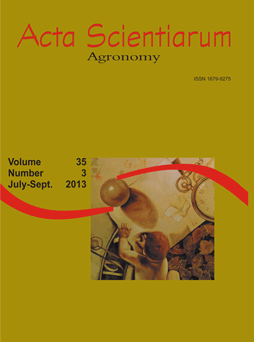<b>Arbuscular mycorrhizal fungi within agroforestry and traditional land use systems in semi-arid Northeast Brazil</b> - doi: 10.4025/actasciagron.v35i3.16213
Resumo
The diversity of arbuscular mycorrhizal fungi (AMF) can be a critical factor in enhancing both the productivity and the diversity of plants in ecosystems, and the plants in the ecosystem also strongly influence the occurrence of these fungi. The relationships between different land use systems and AMF communities in the semi-arid region of the State of Paraíba, NE Brazil were evaluated. The experiment followed a split-plot randomized block design, with four replicates. The main plots were defined by the presence or absence of trees (gliricidia and maniçoba), while the split plots were defined by three land use systems: 1) traditional cropping of maize + beans, 2) buffel grass pasture, and 3) prickly pear forage crop. The presence of trees increased sporulation, mycorrhizal colonization and the production of infective propagules of AMF in all three land use systems. Greater production of glomalin-related soil protein (GRSP) occurred in the prickly pear plots regardless of the presence or absence of trees. Species belonging to the Glomus genus predominated regardless of the presence of trees, land use systemor soil sampling period.
Downloads
DECLARAÇÃO DE ORIGINALIDADE E DIREITOS AUTORAIS
Declaro que o presente artigo é original, não tendo sido submetido à publicação em qualquer outro periódico nacional ou internacional, quer seja em parte ou em sua totalidade.
Os direitos autorais pertencem exclusivamente aos autores. Os direitos de licenciamento utilizados pelo periódico é a licença Creative Commons Attribution 4.0 (CC BY 4.0): são permitidos o compartilhamento (cópia e distribuição do material em qualqer meio ou formato) e adaptação (remix, transformação e criação de material a partir do conteúdo assim licenciado para quaisquer fins, inclusive comerciais.
Recomenda-se a leitura desse link para maiores informações sobre o tema: fornecimento de créditos e referências de forma correta, entre outros detalhes cruciais para uso adequado do material licenciado.




















































